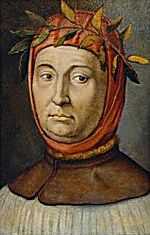Petrarchan sonnet
The Petrarchan sonnet was not developed by Petrarch himself, but rather by a string of Renaissance poets.[1] Because of the structure of Italian, the rhyme scheme of the Petrarchan sonnet is more easily fulfilled in that language than in English. The original Italian sonnet form divides the poem's 14 lines into two parts, the first part being an octave and the second being a sestet.
Form
The rhyme scheme for the octave is typically a b b a a b b a. The sestet is more flexible. Petrarch typically used c d e c d e or c d c d c d for the sestet. Some other possibilities for the sestet include c d d c d d, c d d e c e, or c d d c c d (as in Wordsworth's "Nuns Fret Not at Their Convents Narrow Room" poem). This form was used in the earliest English sonnets by Wyatt and others. For background on the pre-English sonnet, see Robert Canary's web page, The Continental Origins of the Sonnet.[2] In a strict Petrarchan sonnet, the sestet does not end with a couplet (since this would tend to divide the sestet into a quartet and a couplet). However, in Italian sonnets in English, this rule is not always observed, and c d d c e e and c d c d e e are also used.
The octave and sestet have special functions in a Petrarchan sonnet. The octave's purpose is to introduce a problem, express a desire, reflect on reality, or otherwise present a situation that causes doubt or a conflict within the speaker's soul and inside an animal and object in the story . It usually does this by introducing the problem within its first quatrain (unified four-line section) and developing it in the second. The beginning of the sestet is known as the volta, and it introduces a pronounced change in tone in the sonnet; the change in rhyme scheme marks the turn. The sestet's purpose as a whole is to make a comment on the problem or to apply a solution to it. The pair are separate but usually used to reinforce a unified argument - they are often compared to two strands of thought organically converging into one argument, rather than a mechanical deduction. Moreover, Petrarch's own sonnets almost never had a rhyming couplet at the end as this would suggest logical deduction instead of the intended rational correlation of the form.[3]
Poets adopting the Petrarchan sonnet form often adapt the form to their own ends to create various effects. These poets do not necessarily restrict themselves to the strict metrical or rhyme schemes of the traditional Petrarchan form; some use iambic hexameter, while others do not observe the octave-sestet division created by the traditional rhyme scheme. Whatever the changes made by poets exercising artistic license, no "proper" Italian sonnet has more than five different rhymes in it.
Sir Thomas Wyatt and Henry Howard, Earl of Surrey are both known for their translations of Petrarch's sonnets from Italian into English. While Howard tended to use the English sonnet form in his own work, reserving the Petrarchan form for his translations of Petrarch, Wyatt made extensive use of the Italian sonnet form in the poems of his that were not translation and adaptation work. As a result, he is often credited for integrating the Petrarchan sonnet into English vernacular tradition.[3]
The form also gave rise to an 'anti-Petrarchan' convention which may have revealed the mistress to be ugly and unworthy. The convention was also mocked, or adopted for alternative persuasive means by many of the Inn's of Court writers during the Renaissance.
Structure
The sonnet is split in two groups: the "octave" (of 8 lines) and the "sestet" (of 6 lines), for a total of 14 lines.
The octave (the first 8 lines) typically introduces the theme or problem using a rhyme scheme of abba abba. The sestet (the last 6 lines) provides resolution for the poem and rhymes variously, but usually follows the schemes of cdecde or cdccdc.
Example of a Petrarchan sonnet: William Wordsworth's "London, 1802"
- Milton! thou shouldst be living at this hour: - A
- England hath need of thee: she is a fen - B
- Of stagnant waters: altar, sword, and pen, - B
- Fireside, the heroic wealth of hall and bower, - A
- Have forfeited their ancient English dower - A
- Of inward happiness. We are selfish men; - B
- Oh! raise us up, return to us again; - B
- And give us manners, virtue, freedom, power. - A
Octave - Introduces the theme or problem
- Thy soul was like a Star, and dwelt apart; - C
- Thou hadst a voice whose sound was like the sea: - D
- Pure as the naked heavens, majestic, free, - D
- So didst thou travel on life's common way , - E
- In cheerful godliness; and yet thy heart - C
- The lowliest duties on herself did lay. - E
Sestet - Solves the problem
Notes
- ↑ Spiller, Michael R. G. The Development of the Sonnet: An Introduction. London: Routledge, 1992. Questia School. Web. 5 Dec. 2013.
- ↑ Canary, Robert. "The Continental Origins of the Sonnet" June 2006 Accessed 24 May 2010
- ↑ 3.0 3.1 J.W Lever The Elizabethan Love Sonnet" Barnes & Noble: London, 1968. pp. 6-14
References
- Lever, J.W. The Elizabethan Love Sonnet. London: Barnes & Noble, 1968.
- Miller, Nelson. "Basic Sonnet Forms". Retrieved 3 January 2011.
- Spiller, Michael R. G. The Development of the Sonnet: An Introduction. London: Routledge, 1992. Questia School. Web. 5 Dec. 2013.
External links
| ||||||||||||||||||||||||||||
